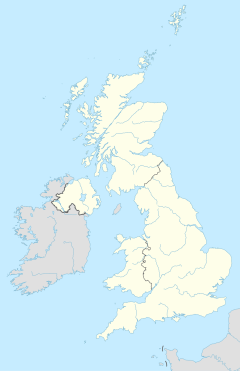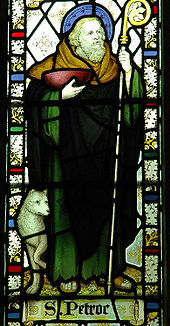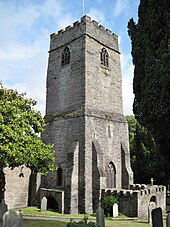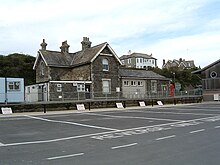Padstow
|
Padstow Cornish Lannwedhenek |
|||
|---|---|---|---|
|
|||
| Coordinates | 50 ° 32 ′ N , 4 ° 56 ′ W | ||
|
|
|||
| Residents | 3162 | ||
| administration | |||
| Post town | PADSTOW | ||
| ZIP code section | PL28 | ||
| prefix | 01841 | ||
| region | South West England | ||
| Ceremonial county | Cornwall | ||
| Civil Parish | Padstow | ||
| Website: Padstow Town Council | |||
Padstow ( Cornish Lannwedhenek ) is a small port town in the north of the English county of Cornwall . It is the administrative seat of the municipality of the same name. The municipality has 3162 inhabitants (2001).
geography
location
Padstow is located on the west bank of the estuary of the River Camel , which rises northeast of the town of Camelford and flows into the Atlantic Ocean at Trebetherick between Pentire Point and Stepper Point on Padstow Bay . The accessibility of the port of Padstow is strongly dependent on the tidal current of the Atlantic.
When the water is low ( ebb ), the sandbanks in front of the site are visible as free beach falls and larger ships can not enter the port during this time, even through the fairway . A particularly dangerous shoal , the sandbank Doom Bar (“ Bank of Fate”), is located directly at the Camel estuary in the Atlantic, east of Steppers Point . It has already been the undoing of many ships.
The open sea of the Atlantic Ocean begins about four kilometers north of the port of Padstow. To the southeast of the port city is the town of Wadebridge , capital of the North Cornwall District, about eight kilometers away . Other nearby cities are Bodmin , ten miles to the southeast, and Newquay , six miles to the southwest. The county town of Cornwall, Truro , is 20 miles from Padstow and is southwest of the city.
The municipality of Padstow includes the village of Trevone on the Atlantic coast and a few small hamlets in the vicinity. In addition to the coast in the north with Cape Stepper Point , Padstow borders on St. Merryn to the west, St. Ervan and Little Petherick (also St. Petroc Minor) to the south, St. Issey to the south-east and St. Issey to the east, separated by the River Camel , to St. Minver .
climate
In Padstow, as in the whole of Cornwall, there is a maritime temperate climate, with it being humid all year round and the winters being particularly mild.
history
The area around Padstow was already after 2000 BC. Settled . During this time the bell-cup culture spread along the coasts of Cornwall. Burial chambers of this culture were discovered on Harlyn Bay west of Trevone. From the 1st century BC BC Venetians settled near today's Padstow and built fortifications on the peninsula. The Venetians were a Celtic tribe from the Gallic Little Britain, today's Brittany in western France .
In the 6th century AD , the missionary Petrock (also Petroc, Cornish Petrek) , who came from South Wales , founded a monastery near the settlement of Lanwethinoc, later Padstow . Petrock, now venerated as a local saint , had studied theology in Ireland and lived from 518 on for 30 years as abbot of his monastery in Lanwethinoc, which was later named Petrocston after him, and from there he proselytized south-west England to Christianity . The monastery, including the church was in the year 981 at an incidence of Denmark at the time of the Danish king I. Harald destroyed.
The importance of Saint Petrock, who died in Bodmin in 564, for Padstow can be seen in the fact that the monastery was active in the derivation of the city's name from the missionary. The name Padstow goes back to the original "The holy place of St. Petrock" . Instead of the monastery name "Petrocston" the place got the English name "Stowe" as a reference to the "holy place" in the 14th century attached to the name of St. Petrock as "Petroc's Stowe" . This later became today's “Padstow” , in which the name of the important Cornish saint lives on.
The monastery was relocated to Bodmin after the destruction by the Danes, whereby Padstow came under the priory of Bodmin. Of the second church built as a replacement, only the foundation of the steeple remained . The preserved until the present day Church St. Petroc Padstow was built from 1420 to 1450, according to other sources to 1415. Even as the monastery in Padstow was this was a "sacred place" by King Athelstan the right to asylum , it Criminals were able to find protection from imprisonment here, which lasted until the Reformation . Economically, the place lived from trade and fishing in the Middle Ages . There were trade relations with Ireland and Brittany via the port, for the processing of which the St. Petroc guild was founded.
During the Reformation, the church lost control of Padstow and their lands became the property of the Prideaux family. At the end of the 16th century they built a stately country house on the former monastery grounds and surrounded it with one of the oldest wildlife parks in the country. The house has remained in their possession to this day as the family seat. However, it is open for viewing in the afternoons a few days a week. Also at the end of the 16th century, Sir Walter Raleigh , an English navigator , explorer and writer , temporarily lived in Padstow. In his capacity as Rector of Cornwall, his courthouse on the banks of the Camel was the central point of collecting taxes and fees. The house still stands today but is privately owned and not open to the public.
In the 17th century, as the Cornwall mines expanded, the port of Padstow was used to ship copper ore to Bristol and to export shale from the quarries near the River Camel . Shipbuilding flourished during the 19th century and a number of shipyards were established. The reason was the flourishing fishing industry and the increasing movement of goods. Products such as fish, wheat, barley, oats, cheese and minerals were increasingly exported from Cornwall, while goods were imported from Ireland, France, Wales, Scandinavia and Russia, among others. To secure the port of Padstow it was expanded and the first lifeboat was stationed before 1827 . The location of the boat is today at Trevose Head , on the open sea northwest of the city.
In 1899 Padstow got a connection to the railroad . The city was the end point of Halwill over Launceston and Wadebridge extending 84 kilometers long route of the North Cornwall Railway , a subsidiary of the London & South Western Railway . In Halwill there was a connection to the main line of the London & South Western Railway and thus a continuous rail connection to the capital London via Exeter . The railway line built to connect the port for economic reasons promoted the beginning of tourism in the city.
In the course of the 20th century there was a decline in the fishing industry, which was enhanced by the closure of the railway line to Padstow in 1967. Tourism, on the other hand, became increasingly important for the city. The former railway line was converted into a hiking and biking trail, the now 27.8 kilometer long Camel Trail via Wadebridge to Bodmin. A small range of commercial shipping was established in the port and fishing also recovered somewhat due to consumption on site and in the surrounding area.
| year | 1801 | 1821 | 1841 | 1861 | 1881 | 1901 | 1911 | 1921 | 1931 | 1951 | 1961 | 1971 | 1981 | 1991 | 2001 | 2011 |
|---|---|---|---|---|---|---|---|---|---|---|---|---|---|---|---|---|
| Residents | 1,332 | 1,700 | 2.145 | 2,341 | 2,109 | 1,566 | 2,480 | 2,180 | 2,465 | 2,852 | 2,675 | 2,780 | 2,625 | 2,845 | 3,162 | 2,993 |
Culture and sights
building
St. Petroc's Church
The Anglican Church of Padstow St. Petroc is dedicated to Saint Petrock, who lived here from 518 and died in Bodmin in 564. It is located on Church Street and consists of a choir , the nave , a north and a south aisle. The bell tower with its six bells was erected on the west side of the building. Next to the tower is the Prideaux-Brune family mausoleum .
According to the registers made by Bishop Walter of Bronescombe , the church was inaugurated on September 28, 1415 by the Bishop of Exeter Edmund Stafford.
Padstow Museum
The small museum not far from the harbor shows a collection of artifacts from the history of Padstow over the past two centuries. It was founded in 1971 by residents of the city under the direction of retired boat builder Bill Lindsay. The museum is located on Market Strand , about 50 meters from the harbor.
Prideaux Place
On the northwestern outskirts of Padstow at the end of Church Street , the Prideaux family's house rises up in a 16-acre park. The Elizabethan manor was built in 1592 on an "E" -shaped floor plan. The two-story building can be viewed on guided tours.
Festivals
'Obby' Oss festival
The celebration on May 1, with the actual name "Hobby Horse" (cornish "Hobihors" ; English for " hobbyhorse ") begins at midnight with the singing of "Morning Song" by the residents of Padstow. The place is decorated around a maypole with flowers and fresh green. During the day, residents dressed in black and wearing cruel masks dance through the streets of the city, the "Obby 'Osses" , depicting stylized horses, driven by "teasers" , men swinging clubs. At the end of the day, the crowd celebrates the death of 'Obby' Oss' until the resurrection on the night of May 1st of the following year. The origins of the festival are unclear, but it is traced back to an ancient fertility rite, possibly the Celtic Beltane festival.
Mummer's Day
Mummer's Day or Darky Day is a tradition of singing Minstrel songs on Boxing Day and New Year's Day when moving through town . The faces are painted black. The custom originally goes back to pagan midwinter festivals ( Yule ) in Cornwall.
sons and daughters of the town
- Rob Barff (* 1974), racing car driver
Individual evidence
- ↑ GENUKI - Population ( Memento of the original from April 2, 2015 in the Internet Archive ) Info: The archive link was inserted automatically and has not yet been checked. Please check the original and archive link according to the instructions and then remove this notice.
- ↑ GENUKI - Registration District of Bodmin ( Memento of the original from August 19, 2009 in the Internet Archive ) Info: The archive link has been inserted automatically and has not yet been checked. Please check the original and archive link according to the instructions and then remove this notice.
- ↑ a b c d e Padstow - North Cornwall / History
- ↑ St. Pedrog, Abbot of Lanwethinoc
- ↑ 4th June - St Petroc's Day! ( Memento of the original from September 11, 2009 in the Internet Archive ) Info: The archive link was automatically inserted and not yet checked. Please check the original and archive link according to the instructions and then remove this notice.
- ↑ GENUKI ( Memento of the original from April 2, 2015 in the Internet Archive ) Info: The archive link was inserted automatically and has not yet been checked. Please check the original and archive link according to the instructions and then remove this notice.
- ↑ The Camel Trail ( Memento of the original from June 7, 2011 in the Internet Archive ) Info: The archive link was automatically inserted and not yet checked. Please check the original and archive link according to the instructions and then remove this notice. (PDF; 217 kB)
- ↑ GENUKI - Church History ( Memento of the original from April 2, 2015 in the Internet Archive ) Info: The archive link was inserted automatically and has not yet been checked. Please check the original and archive link according to the instructions and then remove this notice.
- ↑ GENUKI - Archives & Libraries ( Memento of the original from April 2, 2015 in the Internet Archive ) Info: The archive link was inserted automatically and has not yet been checked. Please check the original and archive link according to the instructions and then remove this notice.
- ↑ Ralf Nestmeyer: Cornwall & Devon , Michael Müller Verlag, Erlangen 2008, page 233, ISBN 978-3-89953-373-6
- ↑ a b Padstow Village Cornwall ( Memento of the original from August 20, 2008 in the Internet Archive ) Info: The archive link was automatically inserted and has not yet been checked. Please check the original and archive link according to the instructions and then remove this notice.
- ^ Ralf Nestmeyer: Cornwall & Devon , Michael Müller Verlag, Erlangen 2008, page 231, ISBN 978-3-89953-373-6







